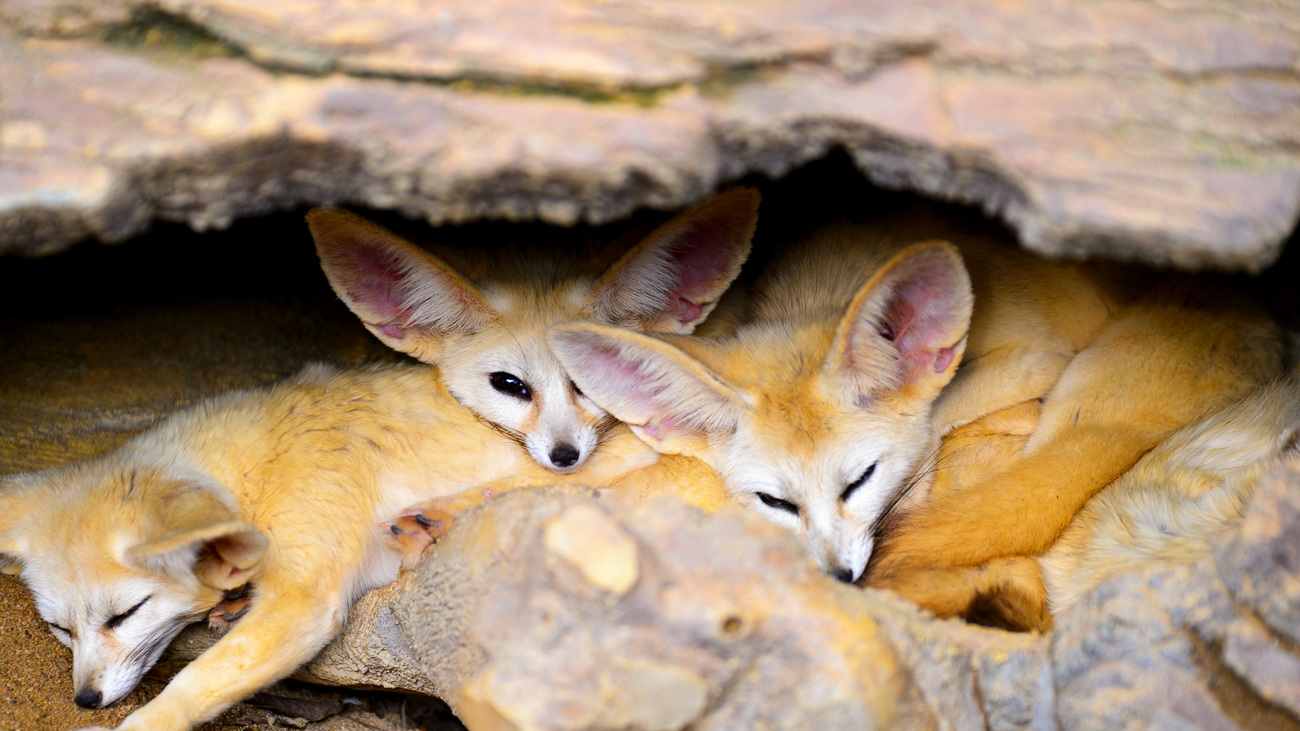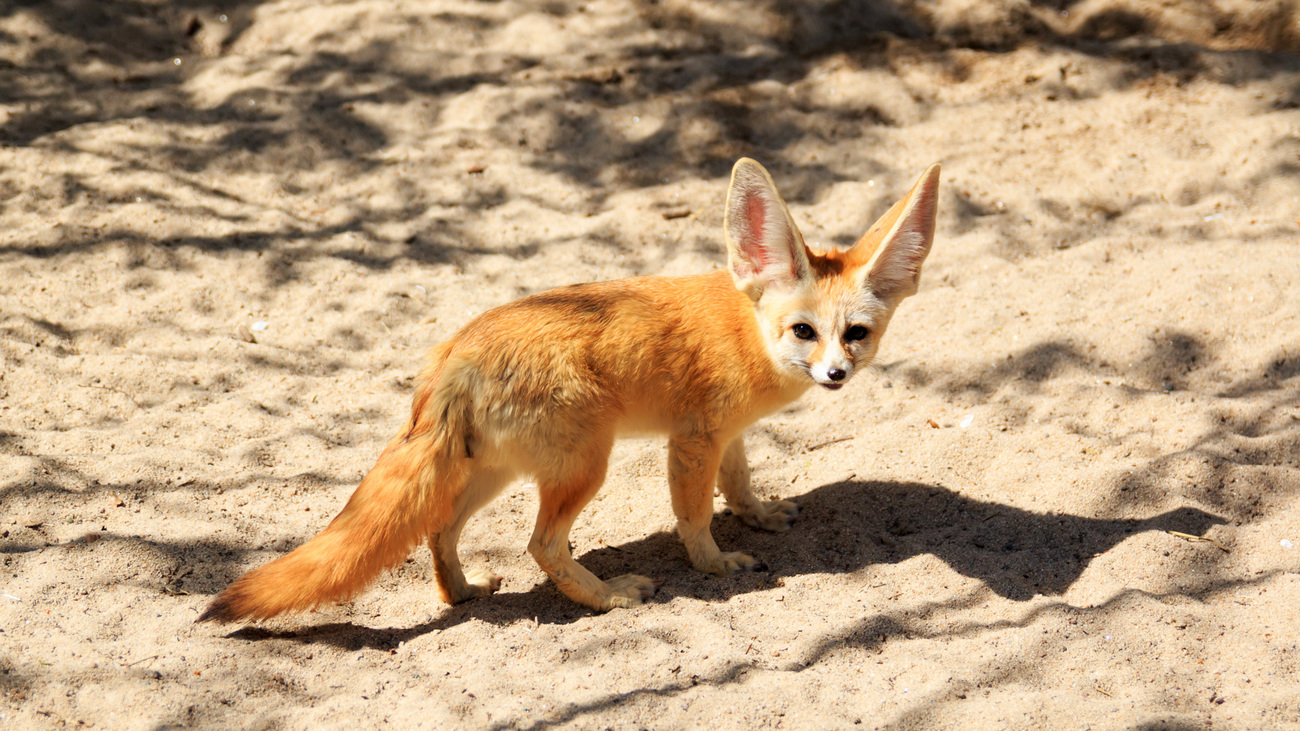Fennec foxes
What are fennec foxes?
Fennec foxes are the smallest species of fox in the world, and they are found in the Sahara Desert. As desert dwellers, they have many useful adaptations to help them endure the hot days, cold nights, and constant dryness.
One noticeable adaptation is their large ears. The fennec fox’s ears are over 15 centimetres (six inches) long and are a great tool for staying cool and locating prey hiding under the sand.
Thick fur is another way these foxes survive the desert. While it seems counterintuitive to have thick fur in a region that can reach 50 degrees Celsius (122 degrees Fahrenheit), it protects their skin from direct sunlight and their paws from the hot sand. Temperatures in the desert also drop drastically at night, so they need their thick fur to stay warm.
To cope with the lack of water in the desert, foxes have specially developed kidneys that conserve water for long periods of time. This means they can go a lot longer without water than many other species. When they do need water, they typically get it from their food sources since there aren’t many water sources to drink from.
That’s not to say that food is easier to find—in fact, fennec foxes have adapted to eating many different kinds of food to ensure they can always get enough nutrition. They forage for different plants but also eat lizards, birds, eggs, rodents, and many insects.
Fennec foxes are social animals and live in small communities of around 10 individuals. Male fennec foxes live together but become aggressive during mating season when they need to compete for mates. Their mating season typically lasts for four to six weeks. When a female gets pregnant, they gestate for about 50 days. Fennec foxes mate for life, and the males stick around during the gestation and birthing period. They continue providing food for their mate until their pups are around four weeks old.
Similar to dogs, fennec foxes give birth to litters of two to five pups that are born blind and open their eyes within about two weeks. They mature at around nine to 11 months old.
Fennec foxes help keep their desert habitat healthy by controlling rodent and insect populations. They are also prey, providing food for species like eagles, jackals, and caracals. Other small species also use the burrows fennec foxes dig for protection from the sun and predators.
What is a fennec fox’s scientific name?
The fennec fox is a member of the Canidae family, and its scientific name is Vulpes zerda. The genus name vulpes means ‘true fox’.
Are fennec foxes endangered?
Fennec foxes have been listed as least concern by the IUCN since 2008 and have a stable population. They’re also legally protected in Morocco, Algeria, Tunisia, and Egypt.
However, fennec foxes still face a number of threats, including the illegal pet trade and the expansion of human activity in the Sahara.
Where do fennec foxes live?
Fennec foxes live in northern Africa, from the most central plains of the Sahara Desert to the coasts of Morocco. The total area of their range is around 8,600,000 square kilometres (3,320,000 square miles), around the same size as the United States. They’re used to the desert’s sandy habitat, where they burrow during the day and hunt or forage at night.
Their large ears help fennec foxes locate prey and dissipate heat to keep cool. They also have thick fur that protects their skin from direct sunlight and keeps them warm during cold desert nights. This thick fur extends to their feet, helping shield their paws from the hot sand.
Threats
The main threats facing fennec foxes are the illegal pet trade and growing levels of human activity in the Sahara Desert.

Exotic pet trade
In North Africa, fennec foxes are caught for exhibition or to be sold as pets to tourists. This is dangerous for the population, because it can create and increase demand for the species, prompting the capture of more individuals. It also causes needless deaths, because trappers kill mother foxes to take their young.
Human development
While the Sahara is largely uninhabited by humans, activity in the region has risen rapidly in recent years. Roads are being constructed, and exploratory drilling activities and oilfield developments are also taking place. These activities endanger fennec foxes, disturb their burrows, and make them vulnerable to road traffic. There are even some new permanent human settlements around the edges of the desert, which have caused the foxes to retreat.
FAQs
What do fennec foxes eat?
Because they live in harsh desert habitats, fennec foxes have adapted to eat whatever they find and can survive for long periods without water. They spend much of their time foraging for leaves, roots, and fruits, but they also eat small birds, eggs, reptiles, insects, and rodents.
How long do fennec foxes live?
Fennec foxes can live in the wild for around 10 to 12 years on average.
How big are fennec foxes?
Fennec foxes are the smallest species of fox, weighing just one and a half kilograms (3.3 pounds). Their body length measures between 36 and 41 centimetres (14 to 16 inches), with a tail as long as 31 centimetres (12 inches). Their famously oversized ears can exceed 15 centimetres (six inches) long.

Where are fennec foxes from?
Fennec foxes can be found in just about any corner of North Africa’s Sahara Desert and other semi-desert areas. This covers countries like Algeria, Chad, Egypt, Libya, Mali, Mauritania, Morocco, Niger, Sudan, and Tunisia.
Why do fennec foxes have big ears?
Fennec foxes’ large ears give them two major advantages. Heat from their bodies travels to their ears and dissipates, helping the foxes stay cool. Because their ears are so large and thin, it significantly increases the ratio of surface area to body mass—and the greater the surface area, the more heat loss.
The second advantage is the ability to hear prey under the sand. Their ears’ large surface area helps them hear better by funnelling more sound to their ears.
Are fennec foxes nocturnal?
Fennec foxes are primarily nocturnal and spend the hottest hours of the day underground in their burrows. This helps them stay cool and conserve energy, which they can then use more efficiently in the evening and night.
What does a fennec fox look like?
The quickest way to identify a fennec fox is by looking at its ears—they should look almost too big for its body. The other important thing to look at is the colour of the fur. Because they live in the desert, fennec foxes are a light sandy colour, perfect for camouflage.
They’re also very small, around 36 to 41 centimetres in length, and have a sleek body shape. Other characteristics include a tiny, pointed snout, large eyes, and a black-tipped tail.
Can you have a fennec fox as a pet?
No, fennec foxes should not be kept as pets. Keeping an exotic pet can be dangerous for both you and the animal.
When animals are removed from their habitats and ecosystems, it is almost impossible for pet owners to recreate these conditions in captivity. The impact of this varies between different species. Some can survive but struggle to thrive, others develop long-term medical problems, and some unfortunately die. Diseases can also be passed between wild animals and humans and between wild animals and domesticated species.
Beyond the animal welfare issues that the exotic pet trade creates, we also need to consider how wild animals end up for sale. When a type of exotic pet becomes popular, poachers capture them in the wild—often targeting young individuals and killing their mothers. The creation of captive-bred populations is also common. In this case, individuals are kept by humans and bred for profit. These animals are often living in inhumane conditions without proper food or medical care. When they need to be shipped to new locations to be sold, the animals can die of dehydration, starvation, or injury on the way.
Are fennec foxes good pets?
Fennec foxes are not suitable pets. They are wild animals that rely on their specific habitat to survive. To learn more, read our FAQ about exotic pets.
Are fennec foxes endangered?
Fennec foxes are listed as least concern by the IUCN and have a stable population. Unlike many species, their habitat is largely untouched by human development. However, the illegal pet trade is a growing concern, as humans go out into the desert to capture wild fennec foxes and sell them as pets.
How can you help?
At IFAW, we are doing everything we can to end the illegal wildlife trade. We’re fighting for better legislation and enforcement, and we’re also locating and stopping individual traders. We run campaigns worldwide to raise awareness of wildlife trafficking and work to decrease the demand for exotic pets and wildlife products. Help us create a better future for animals, people, and the planet.